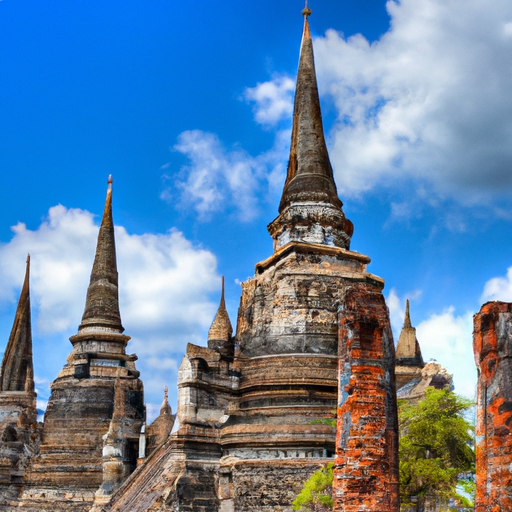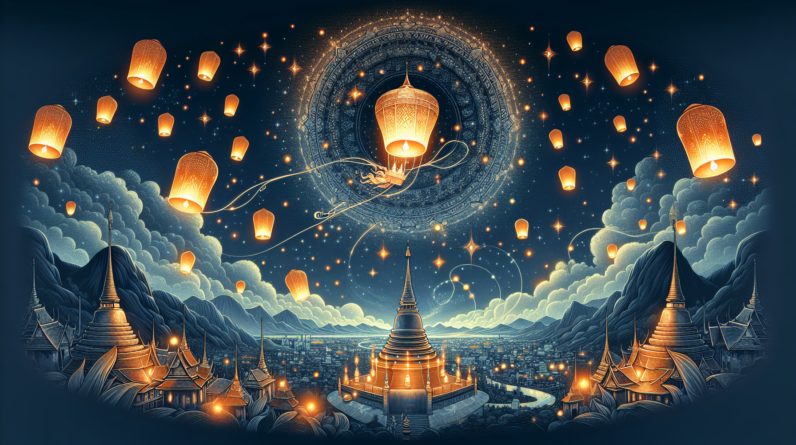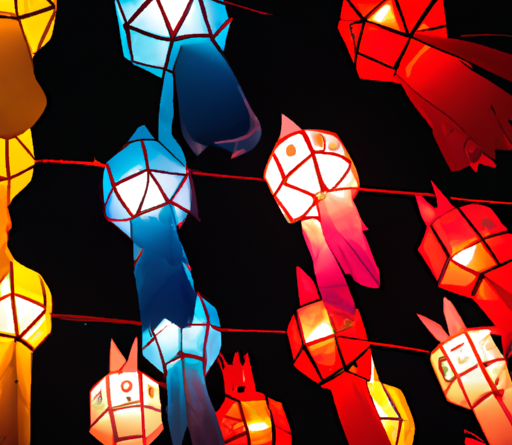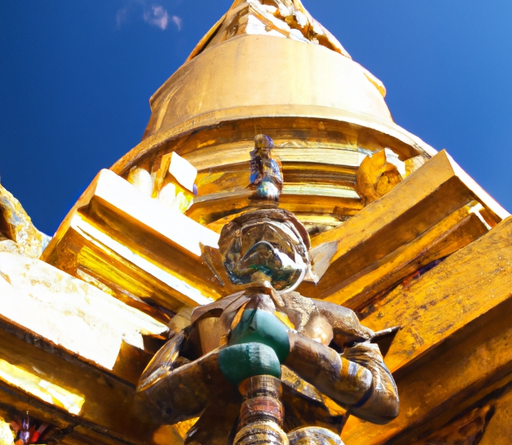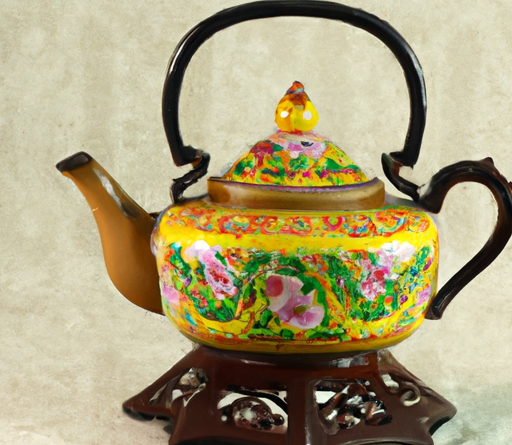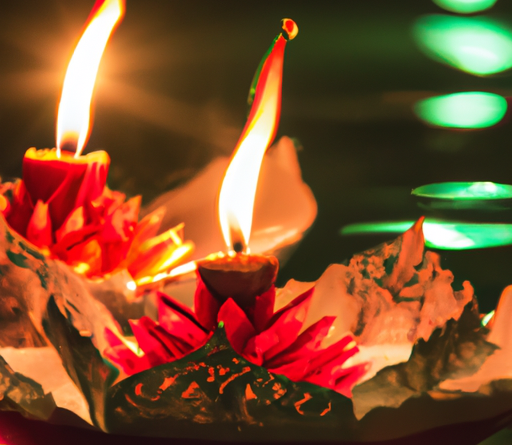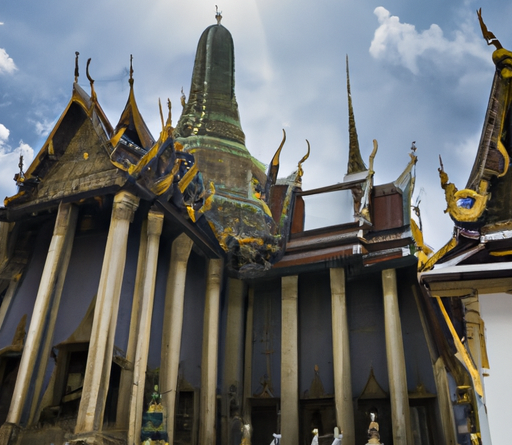
Get ready to immerse yourself in the rich history of Bangkok as we take you through the city’s mesmerizing array of historic landmarks. From the awe-inspiring Grand Palace and its stunningly intricate architecture to the serene Wat Arun temple perched on the banks of the Chao Phraya River, every corner of this vibrant city is steeped in centuries-old stories waiting to be discovered. Let us be your guide as we explore the enchanting tales and hidden gems that make up Bangkok’s bewildering bevy of historic landmarks.
Planning your Visit
Visiting Bangkok can be an exciting and enriching experience, especially when you take the time to explore the city’s fascinating historic landmarks. With so many options to choose from, it’s important to plan your visit to make the most of your time and ensure you don’t miss out on any must-see sights. In this article, we will guide you through researching the landmarks, creating an itinerary, and considerations for visiting these historic sites.
Researching the Landmarks
Before embarking on your Bangkok adventure, it’s essential to do some research on the historic landmarks you wish to visit. Bangkok is renowned for its rich cultural heritage and offers a bewildering bevy of landmarks to explore. Take the time to learn about each site’s significance, history, and unique features.
For a comprehensive understanding of Bangkok’s history, a visit to the Bangkok National Museum is highly recommended. Here, you can immerse yourself in ancient artifacts, traditional art, and historical exhibitions that provide valuable insights into Thailand’s past.
Creating an Itinerary
With the vast array of landmarks in Bangkok, creating a well-planned itinerary is key to making the most of your visit. Consider how much time you have available and prioritize the landmarks you wish to see. It’s a good idea to group sites that are located in close proximity to one another to save travel time.
Start your itinerary with the Grand Palace, a magnificent complex that showcases the opulence of Thai architecture and the country’s royal history. From there, you can explore nearby landmarks such as Wat Phra Kaew and Wat Pho, which house stunning Buddhist art and statues.
Afterward, head to Wat Arun, also known as the Temple of Dawn, and witness the breathtaking sunrise or sunset over the Chao Phraya River. Finally, visit Wat Saket, also known as the Golden Mount, for panoramic views of Bangkok’s skyline.
Considerations for Visiting
When visiting Bangkok’s historic landmarks, it’s important to consider a few practicalities to ensure a smooth and enjoyable experience.
Firstly, dress respectfully. As these sites hold religious and cultural significance, it’s crucial to cover your shoulders and knees. This applies to both men and women.
Secondly, be prepared for large crowds, especially at popular landmarks such as the Grand Palace. To avoid the crowds, plan to arrive early in the morning or later in the afternoon. Additionally, check the opening hours and any ongoing renovations or closures before your visit.
Lastly, consider hiring a local guide, especially if you are interested in learning more about the historical, cultural, and architectural aspects of these landmarks. A knowledgeable guide can provide valuable insights and enhance your overall visit.
Now that you have planned your visit, let’s dive into the specific details of some of Bangkok’s most iconic landmarks.
Grand Palace
Overview of the Grand Palace
The Grand Palace is an architectural masterpiece that served as the residence of Thai kings for over 150 years. It is a sprawling complex that encompasses several impressive buildings, including the famous Wat Phra Kaew, also known as the Temple of the Emerald Buddha.
Must-See Sights within the Grand Palace
While exploring the Grand Palace, make sure to visit Wat Phra Kaew. This temple is home to the highly revered Emerald Buddha, a small statue made of jade. Marvel at the intricate details of the Buddha image and the ornate decoration of the temple.
Another must-see sight within the Grand Palace is the Chakri Maha Prasat Hall. This majestic building showcases a unique blend of Thai and European architectural styles. Admire its grandeur and learn about its historical significance as the site of royal ceremonies and receptions.
Tips for Visiting the Grand Palace
To make the most of your visit to the Grand Palace, it’s advisable to arrive early in the morning to beat the crowds. The complex can get extremely busy, so purchasing your tickets in advance or joining a guided tour can help skip the lines.
Remember to dress appropriately, covering your shoulders and knees. If you forget, don’t worry – there are rental shops where you can borrow appropriate clothing at the entrance.
Be mindful of local customs and observe a respectful demeanor throughout your visit. The Grand Palace is not simply a tourist attraction; it is still used for official events and ceremonies, so it’s important to be considerate.
Now that you’ve explored the Grand Palace, let’s move on to another iconic landmark: Wat Arun.
Wat Arun
Introduction to Wat Arun
Wat Arun, commonly known as the Temple of Dawn, is one of Bangkok’s most recognizable landmarks. This stunning temple is located on the western bank of the Chao Phraya River and derives its name from the Hindu god Aruna, who is often depicted as the radiant glow of the rising sun.
Exploring the Temple Complex
As you approach Wat Arun, you will be captivated by its central tower, or prang, which stands at an impressive height of over 70 meters. This iconic structure is encrusted with colorful porcelain tiles, intricately portraying various mythical creatures and patterns.
Climbing up the steep stairs of the central prang can be a thrilling experience, providing panoramic views of the river and the surrounding area. Take your time to explore the beautifully landscaped gardens and the other smaller prangs within the temple complex.
Watching the Sunrise or Sunset
For a truly magical experience, consider visiting Wat Arun during sunrise or sunset. The first rays of the sun casting a golden hue on the temple’s porcelain exterior create a breathtaking sight, while the temple illuminated against the darkening sky during sunset is equally enchanting.
Remember to check the timings of the sunrise or sunset beforehand, and plan your visit accordingly. Arriving a bit early will ensure you secure a good spot to fully absorb the mesmerizing beauty of Wat Arun.
With the Temple of Dawn explored, let’s move on to another remarkable landmark – Wat Phra Kaew.
Wat Phra Kaew
Introduction to Wat Phra Kaew
Wat Phra Kaew, also known as the Temple of the Emerald Buddha, is one of the most significant and revered temples in Thailand. Situated within the grounds of the Grand Palace, this temple is home to the Emerald Buddha, a national treasure and a highly revered symbol of the Thai monarchy.
The Emerald Buddha
The Emerald Buddha, despite its name, is actually carved from a single block of jade rather than emerald. This small statue depicts a seated Buddha in a meditating position and is believed to have originated in India over 2,000 years ago.
Even though the statue is relatively small, measuring only 66 centimeters in height, its cultural and religious significance is immense. It is deeply revered by the Thai people, and different robes are ceremoniously changed on the statue to correspond with the changing seasons.
Other Significant Sights in Wat Phra Kaew
While the Emerald Buddha is undoubtedly the highlight of Wat Phra Kaew, the temple complex itself is a marvel to explore. Graced with intricate architecture, vibrant colors, and ornate decorations, every corner of the temple showcases the grandeur of Thai craftsmanship and artistry.
Take the time to wander through the temple grounds and admire the stunning murals that depict scenes from mythological stories and Thai history. Marvel at the intricate details of the surrounding buildings, such as the Phra Sri Rattana Chedi and the Golden Stupa.
Remember to dress appropriately and be respectful during your visit to Wat Phra Kaew. As this temple holds significant religious importance, it’s crucial to observe a reverential attitude and follow any guidelines given by the temple staff.
Now let’s continue our journey and discover the wonders of Wat Pho.
Wat Pho
Overview of Wat Pho
Also known as the Temple of the Reclining Buddha, Wat Pho is another must-visit landmark in Bangkok. It is one of the oldest and largest temple complexes in the city, and it houses the famous Reclining Buddha, a sight that will leave you in awe.
The Reclining Buddha
As you enter the temple, you will be greeted by the magnificent Reclining Buddha – a golden statue that stretches an impressive 46 meters in length. This awe-inspiring masterpiece is covered in gold leaf and exudes a sense of peace and serenity.
Take your time to marvel at the intricate details of the statue’s feet, which are adorned with mother-of-pearl illustrations representing various Buddhist symbols and teachings. The tranquil atmosphere and the gentle sound of chanting monks add to the spiritual ambiance of Wat Pho.
Traditional Thai Massage at Wat Pho
Aside from the Reclining Buddha, Wat Pho is also home to Thailand’s first public university and serves as a center for traditional Thai medicine and massage. You can indulge in a traditional Thai massage at Wat Pho, where skilled therapists will knead away any tension in your body.
The massage is based on ancient healing practices and involves a combination of acupressure, stretching, and deep tissue work. It is a rejuvenating experience that will leave you feeling relaxed and refreshed.
Before leaving Wat Pho, explore the tranquil courtyards and gardens within the temple complex. The well-manicured grounds provide a peaceful retreat from the bustling city outside.
Now that you’ve experienced the marvels of Wat Pho, let’s move on to another historic gem – Wat Saket.
Wat Saket
Introduction to Wat Saket
Perched atop a hill in the heart of Bangkok, Wat Saket, also known as the Golden Mount, offers not only a sacred place of worship but also stunning panoramic views of the city. This temple holds significant cultural and historical importance and is a must-visit during your time in Bangkok.
Climbing the Golden Mount
To reach the Golden Mount, prepare yourself for a climb of 318 steps. As you ascend higher, the views of the city become increasingly breathtaking. The climb might be a bit strenuous, but the reward of reaching the top is truly worth it.
Along the way, you will encounter various religious monuments, including bells that can be rung for good luck. Take your time to appreciate the peaceful atmosphere and the beautiful gardens that surround the path to the summit.
Panoramic Views of Bangkok
Upon reaching the top of the Golden Mount, you will be rewarded with panoramic views of Bangkok’s skyline. Here, you can admire the sprawling metropolis from a different perspective, away from the hustle and bustle of the streets below.
Visit Wat Saket during sunset for a truly magical experience. As the sun dips below the horizon, the golden hues cast on the cityscape create a mesmerizing sight. Remember to bring your camera to capture this awe-inspiring scenery.
With the beauty of Wat Saket etched in your memory, let’s now unravel the captivating story of the Jim Thompson House.
Jim Thompson House
Overview of Jim Thompson House
The Jim Thompson House is a fascinating museum and architectural gem that chronicles the life and legacy of Jim Thompson, an American entrepreneur who played a pivotal role in reviving the Thai silk industry. The house itself is a work of art, showcasing traditional Thai architecture and exquisite craftsmanship.
History of Jim Thompson
Jim Thompson was an American serviceman who fell in love with Thailand and eventually settled there in the 1950s. He played a crucial role in revitalizing the Thai silk industry and brought global recognition to Thai silk through his business ventures.
Tragically, Jim Thompson mysteriously disappeared in the Malaysian jungles in 1967, leaving behind a legacy that still captivates visitors today. The Jim Thompson House serves as a tribute to his life and contributions to Thai culture.
Exploring the House and Museum
Upon entering the Jim Thompson House, you will be greeted by a tranquil oasis amid the bustling city. The complex consists of several traditional teakwood houses, beautifully connected by lush gardens and walkways.
Take a guided tour to fully appreciate the intricate architectural details and learn about Jim Thompson’s life from knowledgeable guides. Admire the art collection and antiques displayed in the various rooms and galleries, which reflect Thompson’s passion for collecting Southeast Asian art.
After the tour, relax at the charming on-site café, surrounded by nature, and enjoy a cup of aromatic Thai tea or indulge in some traditional Thai cuisine.
With the legacy of Jim Thompson explored, let’s delve into the world of art and history at the Bangkok National Museum.
Bangkok National Museum
Introduction to Bangkok National Museum
The Bangkok National Museum is a treasure trove of history and culture, showcasing a vast collection of Thai artifacts spanning centuries. It is the largest museum in Southeast Asia and offers a comprehensive insight into Thai art, archaeology, and history.
Highlights of the Museum
As you explore the museum, you’ll come across a myriad of artifacts that illuminate Thailand’s rich cultural heritage. From ancient sculptures and religious icons to exquisite traditional costumes and royal regalia, every corner of the museum is filled with fascinating displays.
A highlight not to be missed is the extensive collection of Buddha images, including rare and venerable statues crafted in different styles and materials. The intricate details and craftsmanship will leave you in awe and provide a deeper understanding of Thailand’s religious traditions.
Tips for Visiting
To make the most of your visit to the Bangkok National Museum, allocate sufficient time to explore the vast collection. The museum is divided into various galleries and buildings, so it’s best to plan your visit accordingly.
Consider taking an audio guide or opting for a guided tour to gain a better understanding of the exhibits and their historical significance. The informative commentary will add depth to your visit and ensure you don’t miss out on any hidden gems within the museum.
Remember to check the museum’s opening hours and any specific guidelines before your visit. Photography is generally allowed, but be mindful of any areas where photography is prohibited.
With the treasures of the Bangkok National Museum witnessed, let’s move on to the awe-inspiring Vimanmek Mansion.
Vimanmek Mansion
Overview of Vimanmek Mansion
Vimanmek Mansion serves as a testament to Thailand’s rich architectural heritage and is the largest teakwood mansion in the world. This magnificent structure was once the royal residence of King Rama V and has since been converted into a museum that affords visitors a glimpse into Thailand’s royal history.
Exploring the Mansion
Step into the grandeur of Vimanmek Mansion and allow yourself to be transported back in time. The mansion consists of over 80 rooms, each exquisitely decorated with a harmonious blend of Thai and European influences.
As you wander from room to room, marvel at the opulent furnishings, delicate artwork, and intricately carved wooden accents. The mansion reflects the refined tastes of King Rama V and offers a fascinating insight into the royal lifestyle of the time.
History and Cultural Significance
Vimanmek Mansion not only showcases the architectural brilliance of Thailand but also holds deep cultural significance. The mansion is a testament to King Rama V’s efforts to modernize and bring Thailand into the global stage while preserving its unique traditions and heritage.
Take your time to explore the surrounding gardens and soak in the tranquility of the lush greenery. The beautifully landscaped grounds provide a serene respite from the bustling city and offer an opportunity to appreciate the natural beauty of Thailand.
With your visit to Vimanmek Mansion complete, let’s conclude our journey with a visit to Wat Traimit.
Wat Traimit
Overview of Wat Traimit
Wat Traimit, also known as the Temple of the Golden Buddha, houses one of the largest solid gold Buddha statues in the world. This revered landmark shines as a beacon of Buddhist spirituality and cultural heritage.
The Golden Buddha
The highlight of Wat Traimit is undoubtedly the Golden Buddha statue, which is an awe-inspiring sight to behold. Weighing an astonishing five and a half tons and standing nearly five meters tall, it is crafted entirely from solid gold. The statue’s estimated value is over 250 million dollars, making it a truly priceless treasure.
The Golden Buddha is believed to date back to the 13th or 14th century and was covered in plaster for protection during times of unrest. It wasn’t until 1955, during a relocation, that the plaster was accidentally chipped off, revealing the stunning gold beneath.
History and Cultural Significance
The Golden Buddha holds immense historical and cultural significance for Thailand. It is believed to have been created during the Sukhothai period and was likely hidden away to protect it from potential invaders or looters.
The statue represents the enlightened and compassionate nature of Buddhism and holds deep spiritual meaning for Thai Buddhists. Its discovery and subsequent display at Wat Traimit have become symbols of Thailand’s rich heritage and the enduring power of Buddhism.
As you gaze upon the Golden Buddha, take a moment to reflect on the profound spiritual significance it holds for millions of people around the world.
Conclusion
Bangkok’s bewildering bevy of historic landmarks offers a captivating journey through Thailand’s fascinating history and culture. From the opulent grandeur of the Grand Palace and Wat Phra Kaew to the serene tranquility of Wat Pho and Wat Saket, each landmark holds its own unique allure.
Exploring the architectural marvels of Wat Arun and Vimanmek Mansion, learning about the life of Jim Thompson at his namesake house, and delving into the rich history and art at the Bangkok National Museum are experiences that shouldn’t be missed.
As you plan your visit, conduct your research, create a well-structured itinerary, and consider practicalities such as dress code, timing, and the option of hiring a local guide. Immerse yourself in the beauty and cultural heritage of Bangkok’s historic landmarks, and let the city’s rich past leave an indelible mark on your memories. Enjoy your visit to these remarkable sites, and embrace the warm embrace of Thai culture and hospitality.
